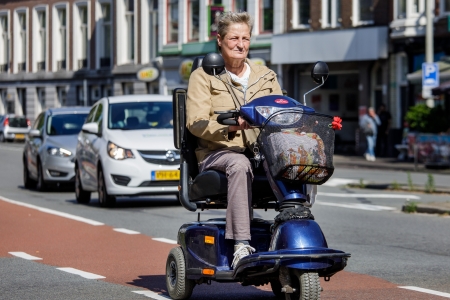Mobility scooters
An in-depth SWOV study of mobility scooter crashes [5] suggests a number of measures to improve road safety for mobility scooters. They mostly involve vehicle and infrastructure measures, in combination with training courses. The preferably combined measures should help prevent ‘typical’ mobility scooter crashes (see the question What are causes of crashes with mobility scooters, enclosed disability vehicles and microcars?):
 |
Vehicle measures
|
 |
Infrastructural measures
These infrastructural measures will also favourably affect road safety for cyclists and light moped riders. |
 |
Customising mobility scooters and trainingConsidering the nature of the users and the absence of fitness-to-drive requirements, mobility scooters should be so user-friendly that anyone can use them after a short instruction period. When delivering mobility scooters under the Social Support Act, the user’s capacities should be taken into account (customised delivery) and appropriate practical training should be ensured. However, a growing number of mobility scooters is privately purchased and they could therefore be less suitable to its users. Practical training sessions will not compensate for this lack of customisation. |
These measures largely correspond to measures suggested by previous studies [10] [21] [22]. The study by Jonkhoff et al. [22] elaborates on the vehicle-related measures that could make mobility scooters structurally safer, and discusses the way in which they could be realised by e.g. legislation or standard requirements. They mention:
- a logically controlled and separate brake;
- emergency stop in the middle of the steering console;
- logical acceleration control;
- improving sensitivity of acceleration control;
- minimum requirements for illuminance level (lux) of headlights;
- rear and (possibly) wheel reflectors;
- minimum height for rear lights;
- seatbelt or airbag.
Enclosed disability vehicles and microcars
For their occupants, enclosed disability vehicles and microcars are inherently unsafe vehicles due to their poor crashworthiness a.o on account of their maximum weight of 350 kilos, and to the sometimes large differences in speed between them and other traffic. Because of their appearance, microcars in particular are almost indistinguishable from ‘ordinary’ small city cars, which makes it hard for other road users to recognise them. These general, inherent characteristics and the lack or scarcity of information about the crash circumstances of these vehicles make it hard to define effective safety measures.
